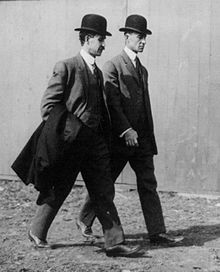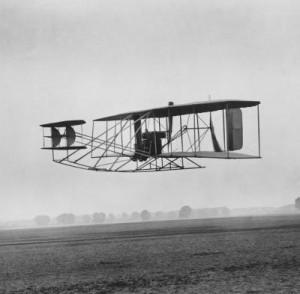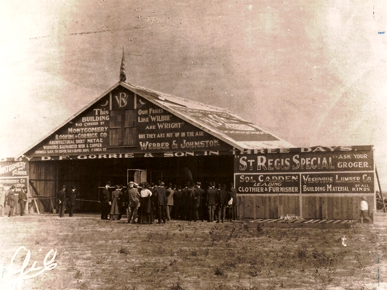The Wright brothers' flight ushered in a new era of travel and created an international revolution. "The Wrights created one of the greatest cultural forces since the development of writing," writes Bill Gates in Time, "for their invention effectively became the World Wide Web of that era, bringing people, languages, ideas and values together."
This great era of aviation was made possible by two self-taught engineers; "the genius of Leonardo da Vinci imagined a flying machine, but it took the methodical application of science by these two American bicycle mechanics to create it," says Gates.
"There is something quintessentially American about Orville and Wilbur Wright's historic achievement," says the Centennial of Flight Commission. "Their intense preoccupation with their airplane was fueled not by economic necessity ... but mostly from their imaginative determination to cross one of the last technological barriers to human flight-stability in the air."
Ready with their muslin and softwood contraption, brothers Orville and Wilbur Wright stood poised along the sandy, barren shores of Kitty Hawk, N.C., on Dec. 17, 1903. A bitter wind blew off the Atlantic Ocean as the Wright brothers decided on a coin toss who would be the first to try out the world's first motorized aircraft.
Chance chose Wilbur to embark on the world's first flight, in which he cruised only a few feet from the ground. Wilbur and Orville Wright took turns at the helm of their revolutionary aircraft in the first of four sustained manned flights, an event that launched the aviation era.
In the spring of 1910, aviation pioneers Wilbur and Orville Wright opened the nation's first civilian flying school on an old cotton plantation on the outskirts of Montgomery, Alabama. The flying school was short-lived, however, as mechanical and weather-related problems forced the brothers to close the facility earlier than planned. The location was later used for aircraft repair during World War I and on November 8, 1922, the installation became Maxwell Field. -Staff Report,
FMI: Re-living the Wright Way
This great era of aviation was made possible by two self-taught engineers; "the genius of Leonardo da Vinci imagined a flying machine, but it took the methodical application of science by these two American bicycle mechanics to create it," says Gates.
Image may be NSFW.
Clik here to view.
Clik here to view.

"There is something quintessentially American about Orville and Wilbur Wright's historic achievement," says the Centennial of Flight Commission. "Their intense preoccupation with their airplane was fueled not by economic necessity ... but mostly from their imaginative determination to cross one of the last technological barriers to human flight-stability in the air."
Image may be NSFW.
Clik here to view.
Clik here to view.

Ready with their muslin and softwood contraption, brothers Orville and Wilbur Wright stood poised along the sandy, barren shores of Kitty Hawk, N.C., on Dec. 17, 1903. A bitter wind blew off the Atlantic Ocean as the Wright brothers decided on a coin toss who would be the first to try out the world's first motorized aircraft.
Chance chose Wilbur to embark on the world's first flight, in which he cruised only a few feet from the ground. Wilbur and Orville Wright took turns at the helm of their revolutionary aircraft in the first of four sustained manned flights, an event that launched the aviation era.
Image may be NSFW.
Clik here to view.
Wright Brothers Flying School-The Wright brothers' civilian flying school, the first in the nation, was founded near Montgomery in 1910. The school operated about two months and graduated one student, Walter Brookins, who made the first recorded night flight on May 25, 1910. Encyclopedia of AL image
Clik here to view.

Wright Brothers Flying School-The Wright brothers' civilian flying school, the first in the nation, was founded near Montgomery in 1910. The school operated about two months and graduated one student, Walter Brookins, who made the first recorded night flight on May 25, 1910. Encyclopedia of AL image
In the spring of 1910, aviation pioneers Wilbur and Orville Wright opened the nation's first civilian flying school on an old cotton plantation on the outskirts of Montgomery, Alabama. The flying school was short-lived, however, as mechanical and weather-related problems forced the brothers to close the facility earlier than planned. The location was later used for aircraft repair during World War I and on November 8, 1922, the installation became Maxwell Field. -Staff Report,
FMI: Re-living the Wright Way
